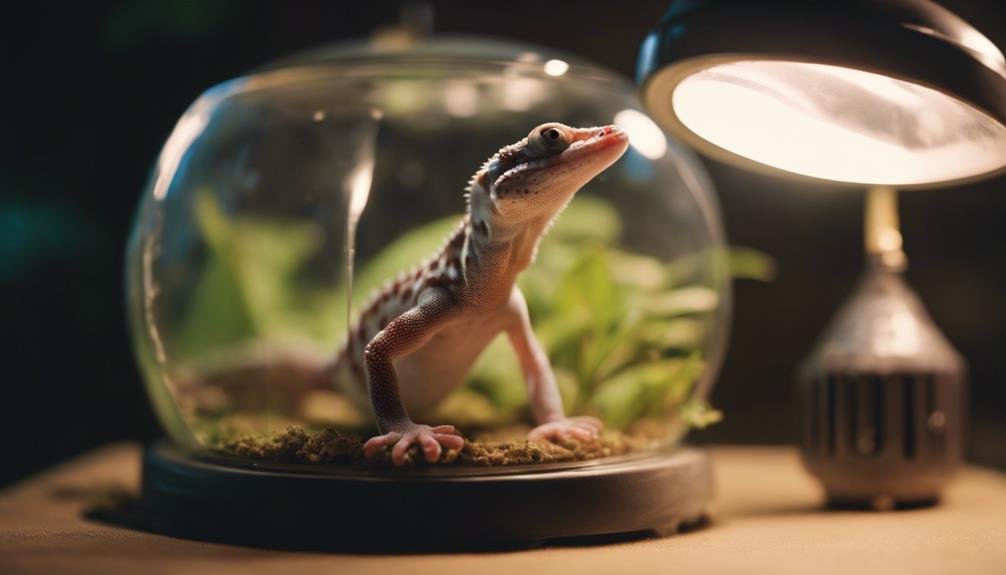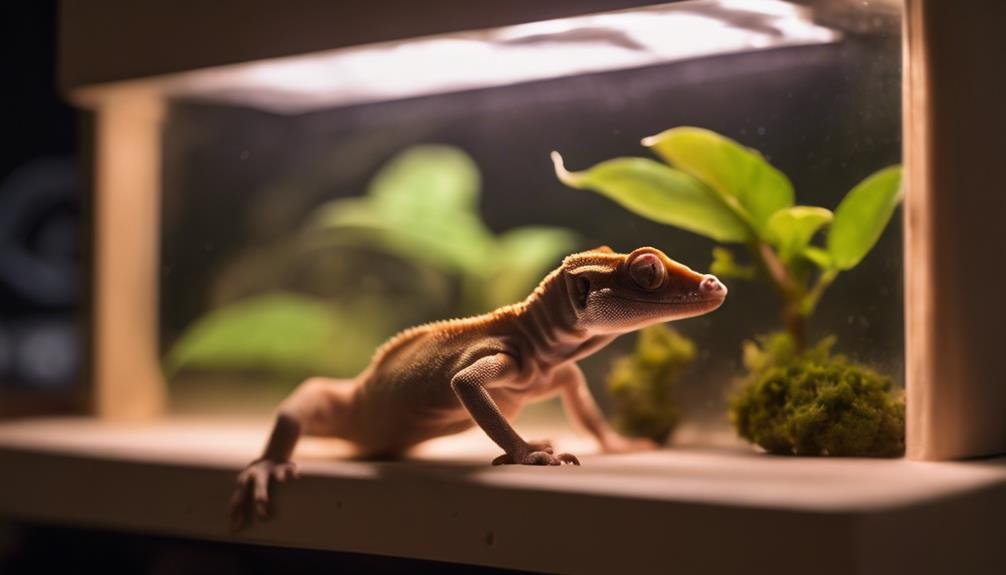You might wonder if your crested gecko needs a heat lamp, or if there's a risk of making their environment too hot or too cold. Ensuring the right balance in their enclosure is vital for their well-being, as both overheating and chilling can pose serious health risks. While they don't necessarily need a heat lamp, guaranteeing their habitat remains within the ideal temperature range is important for their health. But how can you provide the perfect environment without risking their well-being? Let's explore the intricacies of managing your pet's comfort effectively, uncovering alternatives to traditional heating methods that might just surprise you.
Key Takeaways
- Crested geckos require a gentle heat source if room temperatures fall below 70 degrees Fahrenheit.
- Ideal daytime temperatures for crested geckos range from 70-80 degrees Fahrenheit, avoiding the need for intense heat lamps.
- Night temperatures should not drop below 50 degrees Fahrenheit, but excessive heat can be detrimental.
- Alternatives like ceramic heat emitters or infrared bulbs are preferred to maintain ideal temperature without light disruption.
- Continuous monitoring of enclosure temperatures is crucial to prevent overheating, which can lead to health issues.
Understanding Crested Gecko Thermoregulation
Crested geckos, being ectothermic, depend on external heat to regulate their body temperature effectively. This means they can't produce their own heat internally like you do. Instead, they use the environment around them to warm up or cool down. For these little reptiles, managing their temperature is critical for their survival and overall well-being. It's all about finding the right balance. Too cold, and they risk hypothermia; too hot, and they could overheat.
They don't require basking spots like their desert-dwelling cousins, but they do need a gentle heat source if the room they're in dips below their comfort zone. This doesn't mean cranking up a heat lamp to tropical temperatures. Instead, it's about providing a warm enough environment that mimics their natural habitat. Monitoring temperatures closely is key to maintaining this balance. You've got to make sure their world isn't too chilly or excessively warm, ensuring their thermoregulation is on point.
Ideal Temperature Ranges
To guarantee your crested gecko's health and comfort, it's essential to maintain daytime temperatures within the 70-80 degrees Fahrenheit range. This ideal temperature range ensures that your pet can thrive, avoiding the stress and health risks associated with temperatures outside their comfort zone. It's equally important not to let night temperatures drop below 50 degrees Fahrenheit, as cooler temperatures can lead to health issues for your crested gecko.
Creating a temperature gradient in the enclosure is vital. This setup allows your crested gecko to regulate its body temperature effectively by moving between warmer and cooler areas as needed. Without this gradient, your pet might struggle to find a comfortable spot, which could lead to stress or illness.
Monitoring temperatures within the enclosure is a key aspect of caring for your crested gecko. Regular checks ensure that the environment remains within the safe range, both during the day and at night. It's particularly important to keep an eye on temperatures to prevent them from exceeding 80 degrees, as higher temperatures can be fatal. By closely monitoring temperatures, you're taking a critical step in providing a safe and comfortable home for your crested gecko.
Risks of Overheating


While maintaining ideal temperatures is vital, it's equally important to avoid the risks of overheating, which can seriously harm your crested gecko. Overheating can lead to heat stress, dehydration, and in severe cases, even death. It's essential to understand that temperatures above 82 degrees Fahrenheit can be fatal for these sensitive reptiles.
Symptoms of overheating include lethargy, a lack of appetite, and your gecko seeking refuge in cooler areas of their habitat. These signs indicate that the heat levels are uncomfortably high and immediate action is needed to reduce the temperature. Using heat sources with high wattage can increase the risk of overheating, so it's advisable to opt for lower wattage options that provide a gentle, more controlled heat.
To make sure your gecko's environment remains within a safe temperature range, closely monitor the temperature levels. This vigilance helps prevent overheating and maintains a comfortable, healthy environment for your crested gecko. Remember, their well-being depends on a balance of proper heat and temperature regulation, making it critical to avoid any extremes that could lead to discomfort or health issues.
Alternatives to Heat Lamps
Understanding the risks of overheating, it's important to explore safe alternatives for heating your crested gecko's habitat. One of the best options you've got is ceramic heat emitters. These devices are fantastic because they provide accurate temperature control and don't emit any light, making them ideal for your nocturnal friend. They're designed to mimic the natural decrease in temperature that occurs at night, ensuring your gecko feels right at home.
Another option you might consider is infrared or moonlight bulbs. These bulbs are a simple and cost-effective way to add a bit of warmth to your gecko's environment. However, keep in mind they may not be as durable as ceramic heat emitters, so you might find yourself replacing them more often.
If your setup isn't suited for bulbs, don't worry. Heating pads or heat tape can offer a steady source of warmth. Just remember, these aren't the best fit for arboreal enclosures where your crested gecko loves to climb. Plus, you'll need to pair them with a thermostat to avoid any risk of overheating.
Monitoring Enclosure Temperatures


You should regularly use a digital thermometer with probes to keep an accurate check on the temperature gradients throughout your crested gecko's enclosure. This is important because the right temperature guarantees your pet's comfort and health. By positioning the temperature probe in different areas, especially at various heights within the tank, you'll get a clear picture of the heat distribution. Remember, it's not just about the warm spots; cooler areas are equally vital for your gecko to regulate its body temperature naturally.
To avoid any surprises, check the temperatures at different times of the day. This helps in maintaining a consistent environment, reducing stress on your gecko. A digital thermometer makes these checks easy and accurate, but don't forget to calibrate it regularly to ensure the readings are accurate.
Keeping a temperature log can be a game-changer. It allows you to track trends over time, making it easier to spot any sudden changes that could indicate a problem. Adjustments based on your log can greatly improve the conditions in your gecko's habitat, ensuring it remains comfortable and healthy. Remember, monitoring and managing the temperature in your crested gecko's enclosure isn't just about avoiding extremes; it's about creating a stable, suitable environment where your pet can thrive.
Is it Possible for Crested Geckos to Experience the Same Temperature Problems as Leopard Geckos?
Yes, it is possible for crested geckos to experience the same temperature problems as leopard geckos. Both species have specific leopard gecko heat requirements that must be met in order to thrive. It is important for reptile owners to closely monitor and provide the correct heat levels for the well-being of their geckos.
Frequently Asked Questions
What Heat Lamps Do Crested Geckos Need?
You'll want to look for heat lamps that support temperature gradients in your crested gecko's enclosure. Ceramic infrared heat emitters or clamp lamps with dimmers are great for providing ambient warmth without disrupting night-time heating.
These options allow you to adjust the heat to maintain the essential temperature range, ensuring your gecko can thermoregulate properly. It's important to monitor the temperature closely to avoid overheating or underheating your pet.
What Is the Best Heating for a Crested Gecko?
The best heating for your crested gecko involves using a ceramic heat emitter with a thermostat for accurate temperature monitoring. This setup guarantees your gecko enjoys consistent warmth without the risk of overheating.
For nighttime temperatures, consider infrared or moonlight bulbs to provide gentle heat. Don't forget humidity control, essential for their well-being. Avoid high wattage bulbs that can make their enclosure too hot.
Proper heating keeps your gecko healthy and happy.
How Do I Know if My Crested Gecko Is Too Cold?
To tell if your crested gecko's too cold, watch for behavior changes like less activity or sluggishness. They might also lose their appetite or flatten against surfaces, trying to soak up any warmth.
Check the moisture levels, too, as they prefer humid environments, but not cold ones. If they're huddling in warm spots more than usual, it's a clear sign they're feeling chilly and might need a warmer spot in their enclosure.
Do Crested Geckos Need a Hot Spot?
You don't need to provide a hot spot for your crested gecko. Their comfort zone lies within a temperature gradient of 70-80°F, ensuring they're neither too hot nor too cold.
Focus on maintaining this range throughout their enclosure, paying close attention to humidity control and night time temperatures, which should slightly drop but stay within their comfort zone.
This approach keeps them healthy without the stress of a concentrated heat source.
Conclusion
So, you've learned that crested geckos don't always need a heat lamp, but keeping them comfy is key. Aim for daytime temps between 70-80°F and nights above 50°F to avoid the dangers of overheating.
If your home runs cool, consider safer alternatives like ceramic heat emitters or infrared bulbs. Always keep an eye on those temps to make sure your gecko's habitat is just right.
Remember, creating a cozy, not too hot or cold, environment is essential for their well-being.


